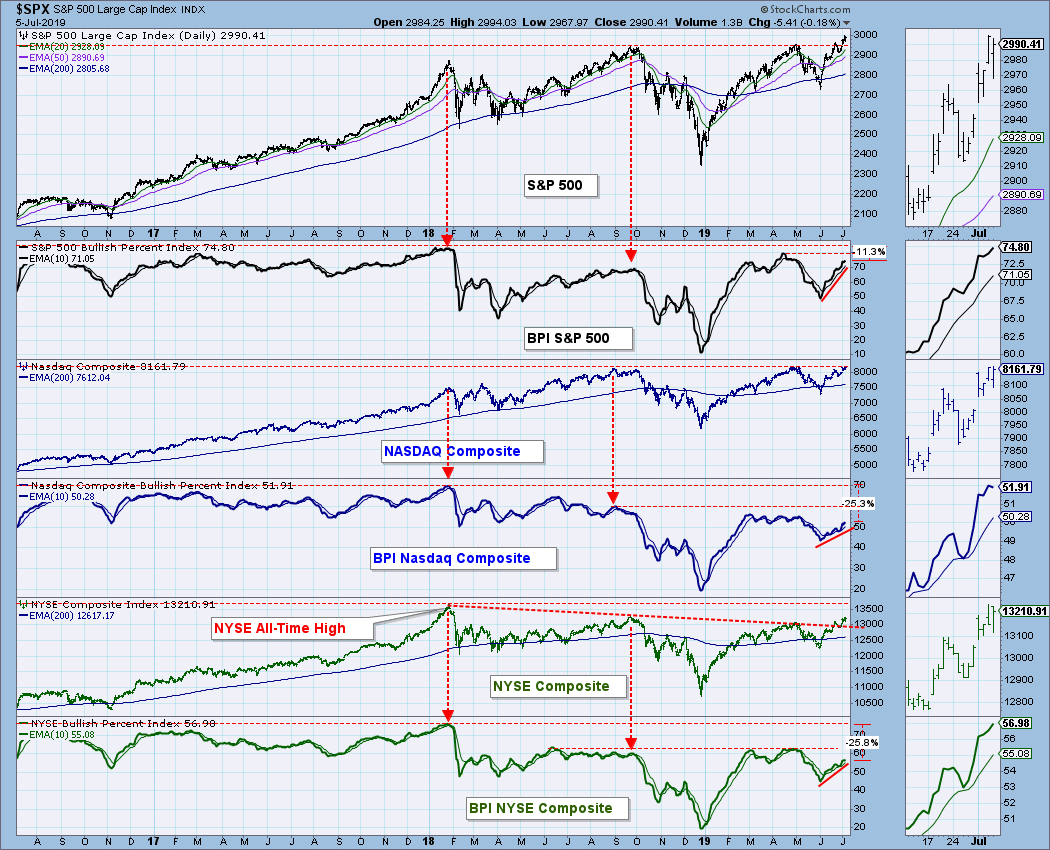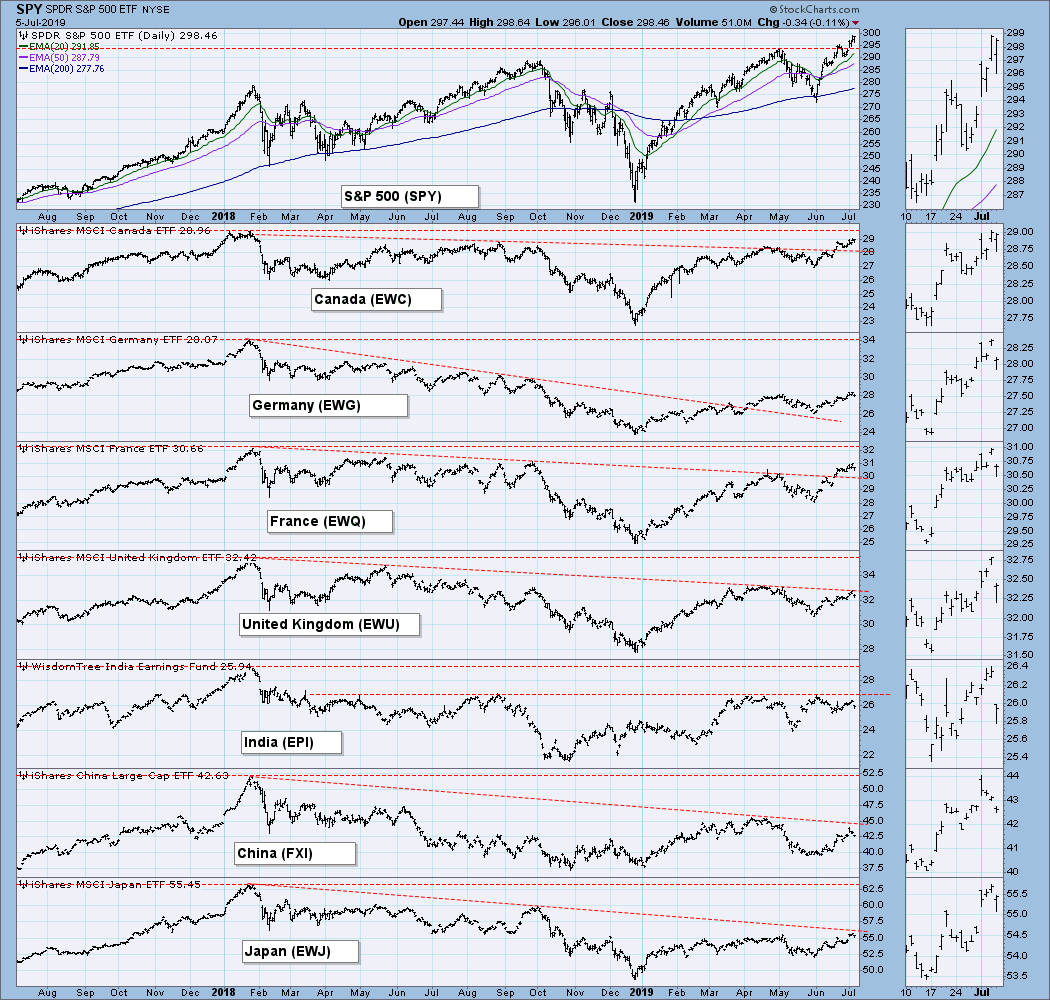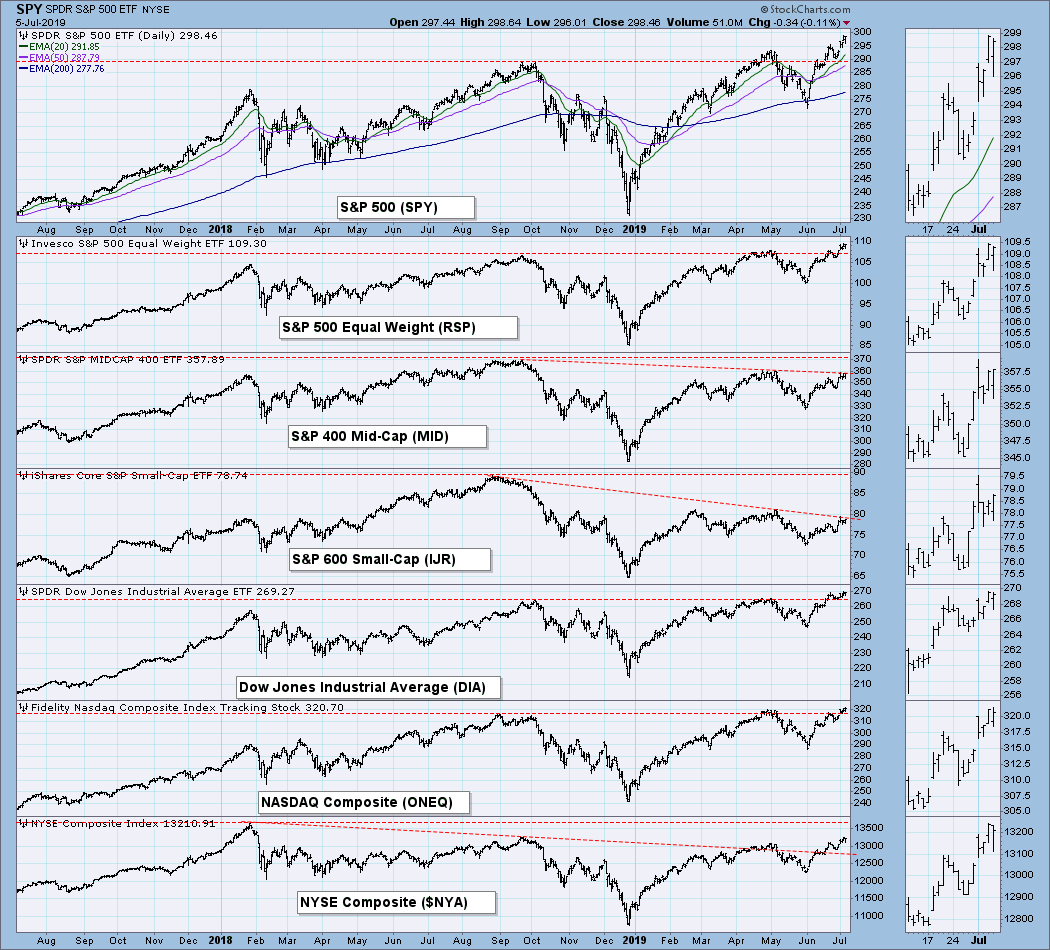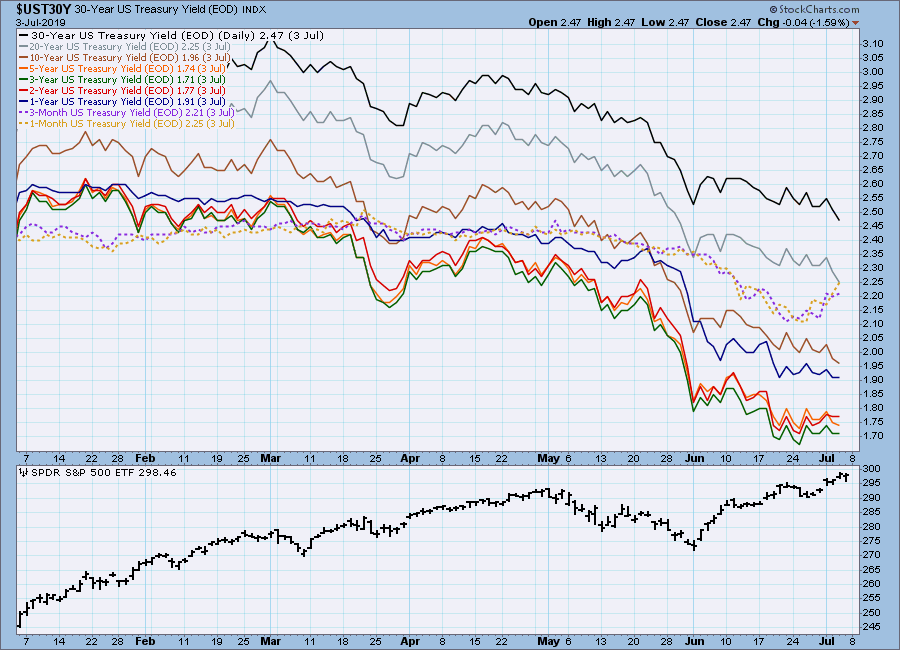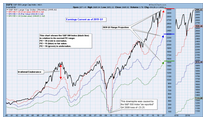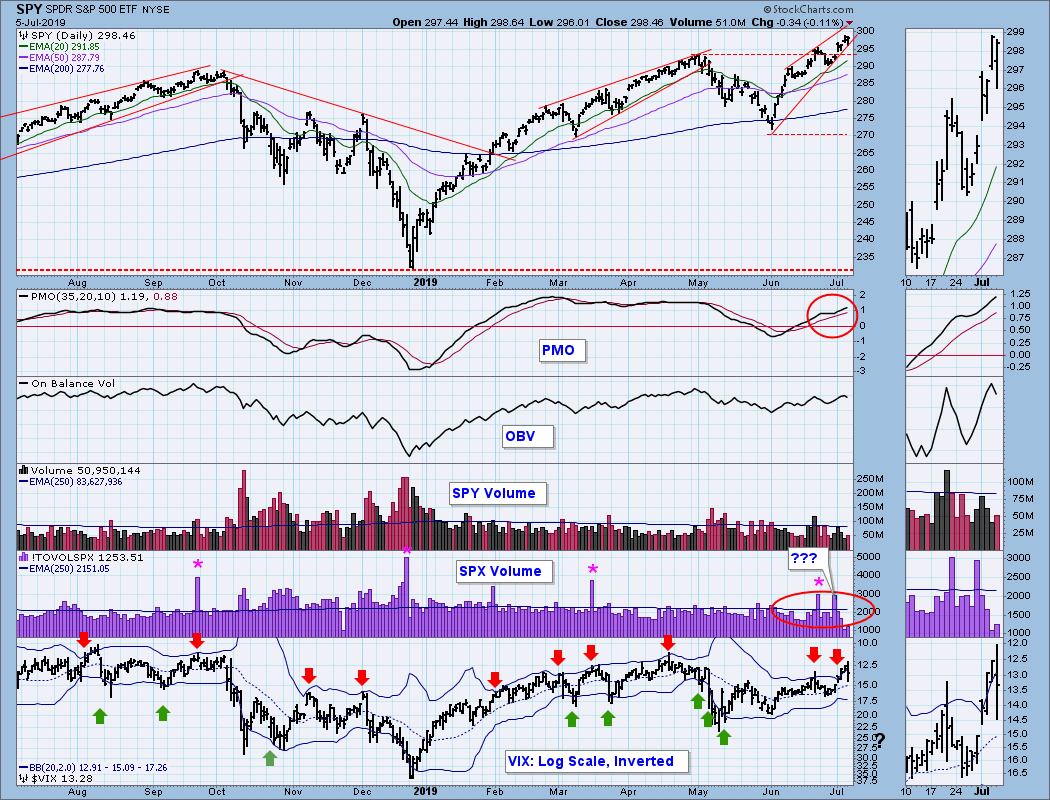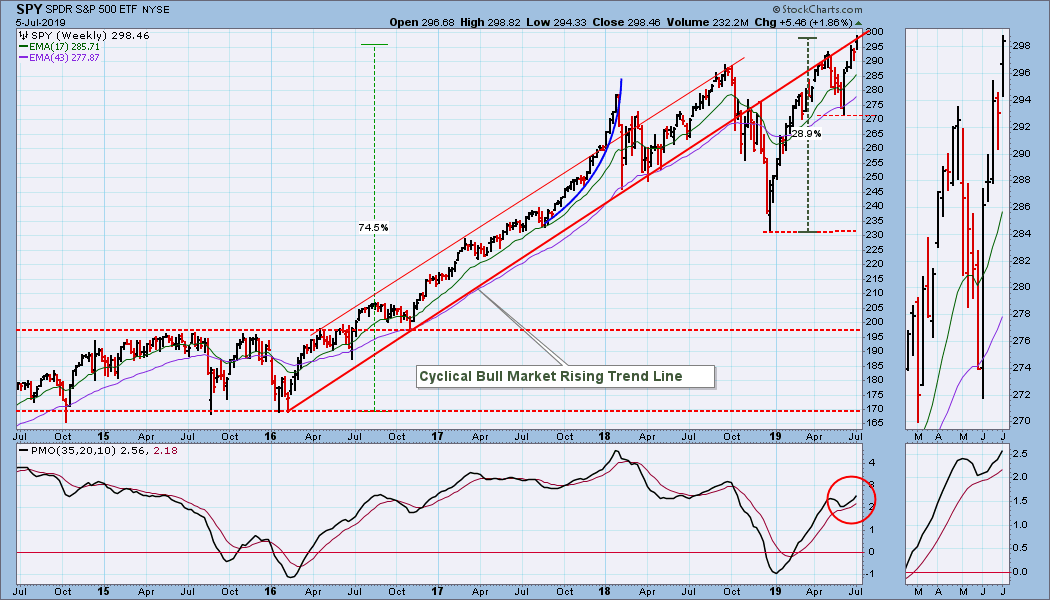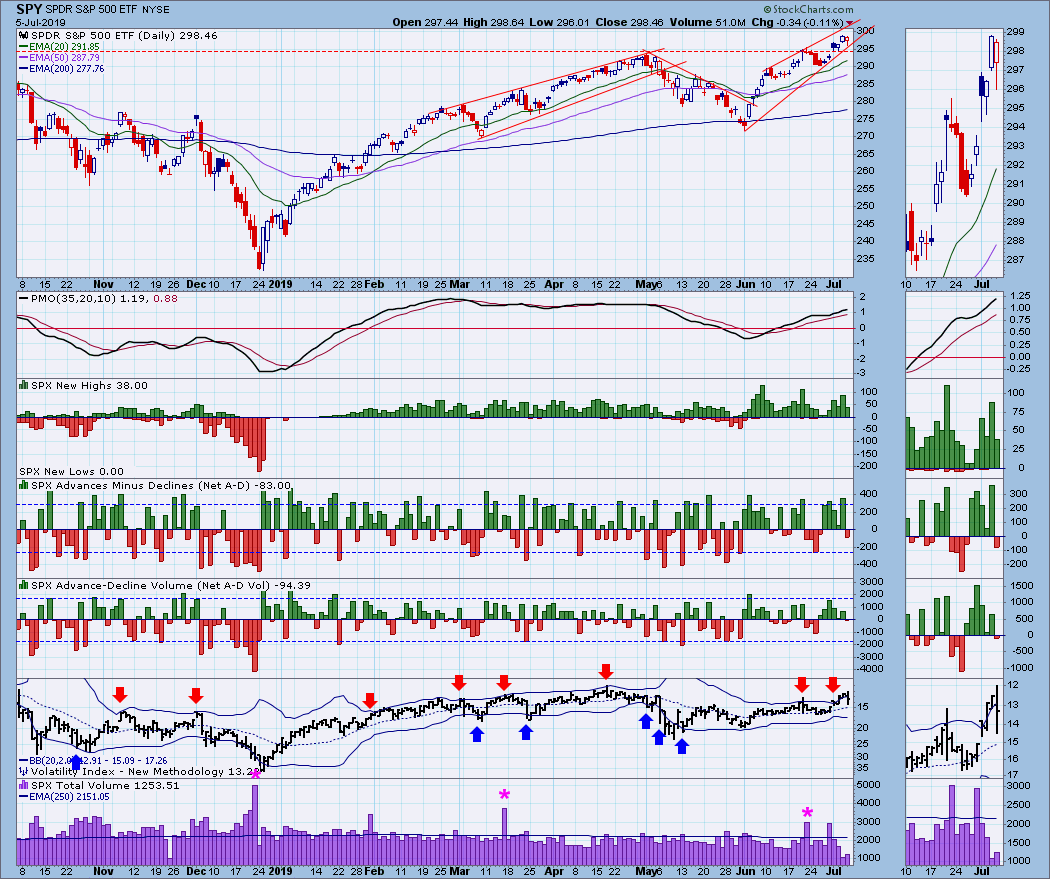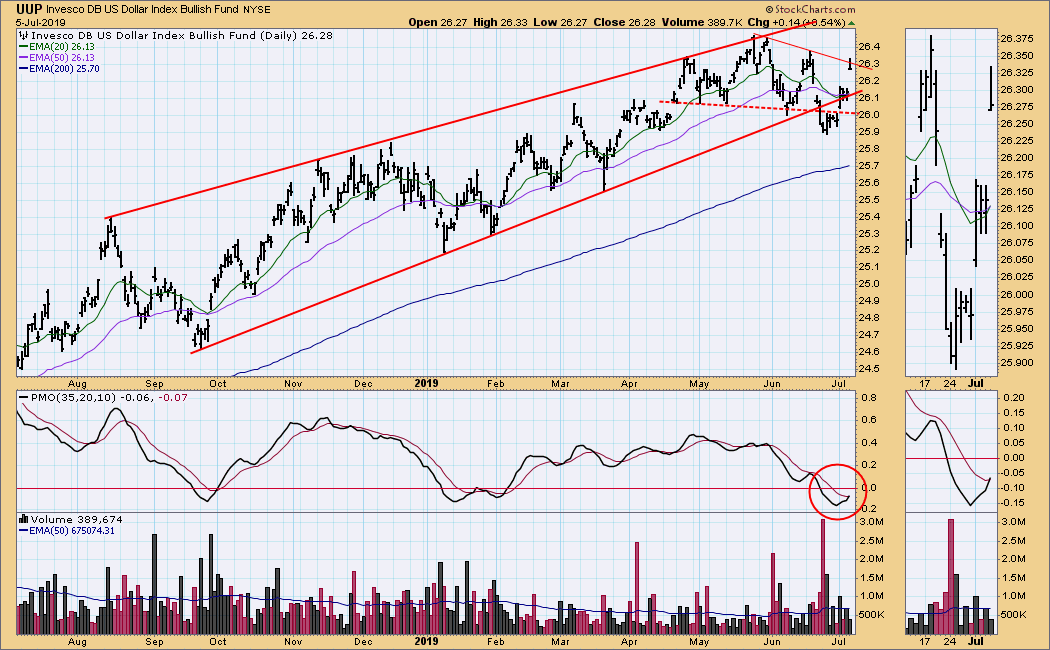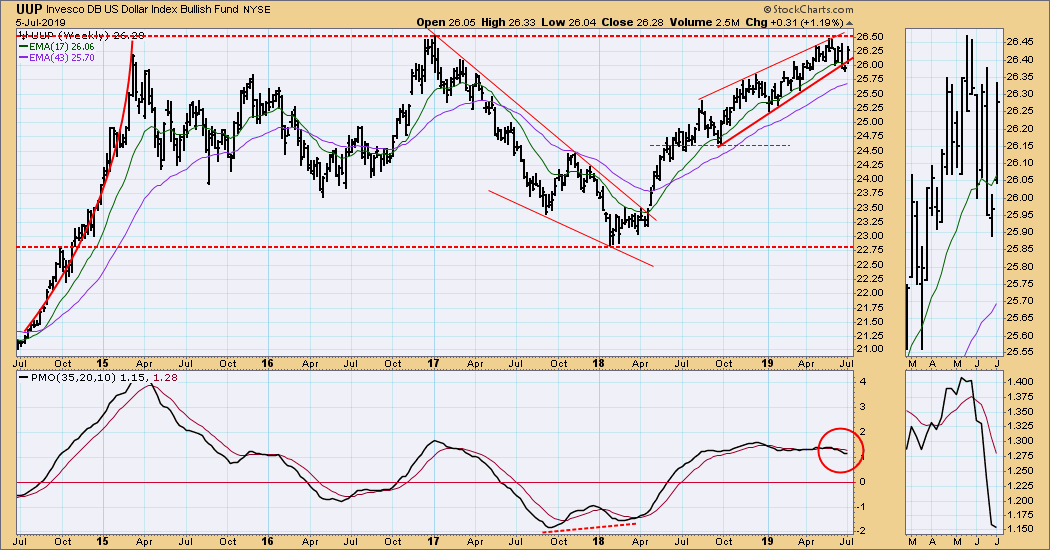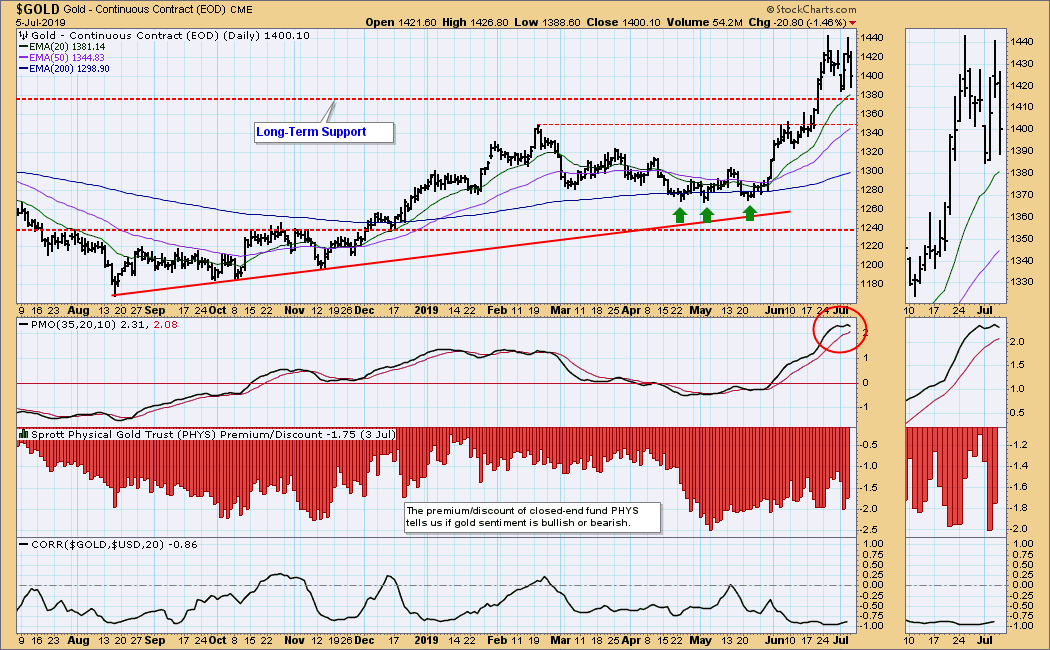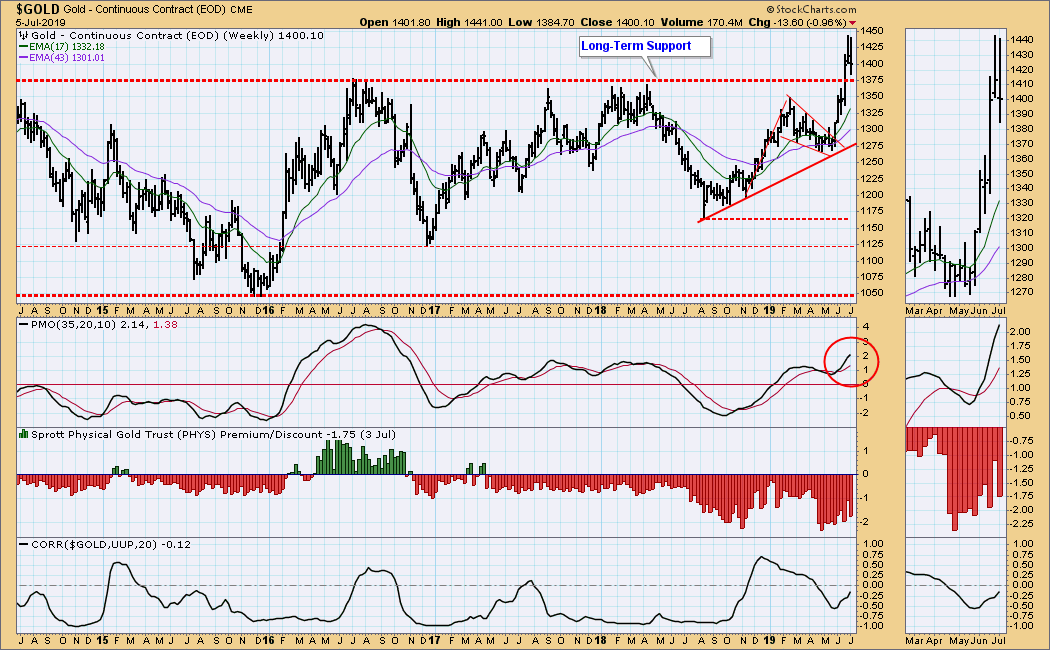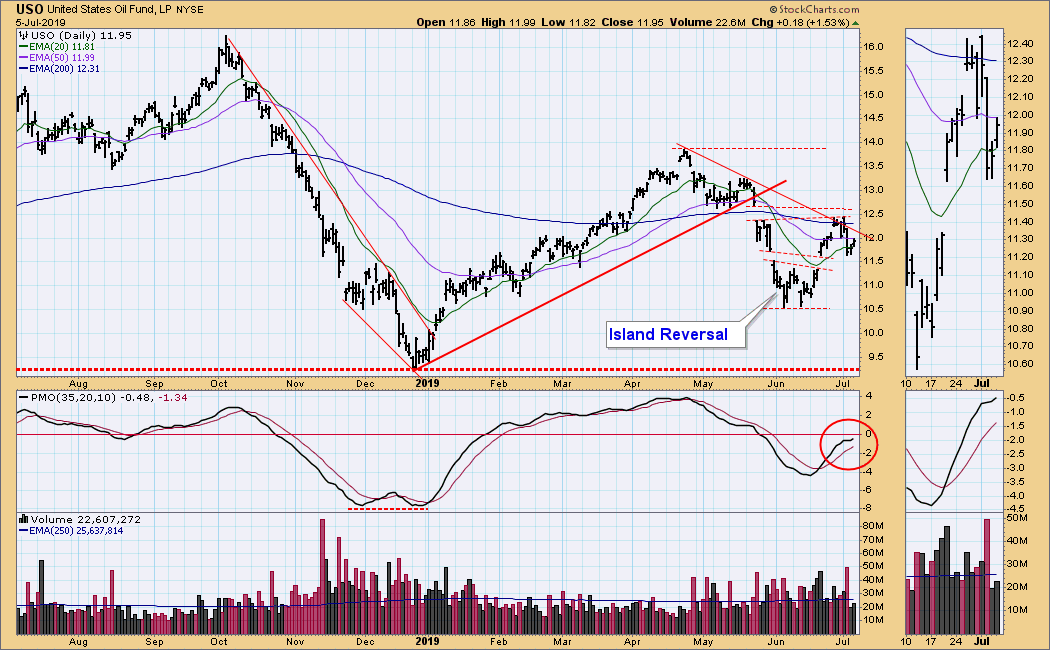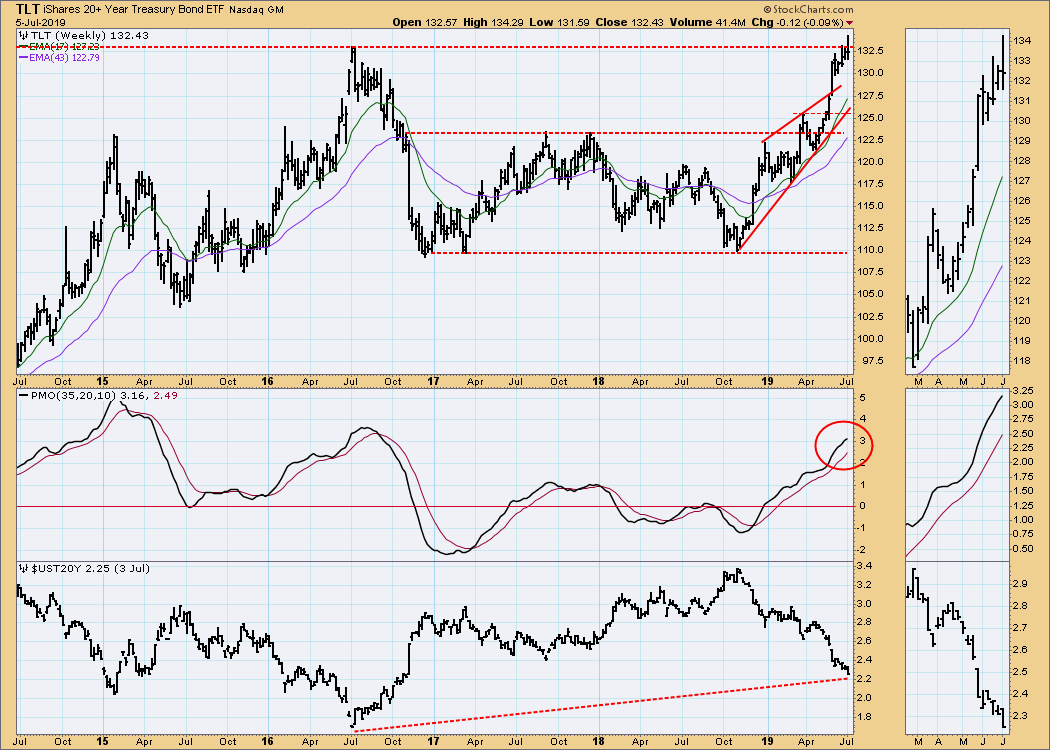
With the S&P 500 and NASDAQ Composite making or equaling all-time highs, it would be appropriate to check the participation behind this up surge. The Bullish Percent Index (BPI) measures the percentage of stocks in a given index that have point & figure BUY signals. In January of 2018 we can see that participation was very healthy with the SPX BPI at over 80, NASDAQ BPI at 70, and the NYSE BPI over 70. At the late-2018 market top, BPI participation was significantly lower, about -15% to -20% for each index. Currently, there has been some improvement in the SPX BPI, down only -11% from the 2018 BPI high, but the NASDAQ and NYSE BPIs are down -25% from their 2018 highs. This is an example of market indexes being supported primarily by large-cap stocks, which is an unhealthy situation. Nevertheless, in the short term we can see that the BPIs have been in a rising trend since June, so for the moment internals have a positive shine; however, if the BPIs break that trend line, watch out.
Notably, the NYSE Composite has been out of step with the SPX and NASDAQ, because, until last month it has remained below a declining tops line defining a bear market for that index. The NYSE BPI does not confirm the recent breakout above that line.
The DecisionPoint Weekly Wrap presents an end-of-week assessment of the trend and condition of the stock market (S&P 500), the U.S. Dollar, Gold, Crude Oil, and Bonds.
Watch the latest episode of DecisionPoint on StockCharts TV's YouTube channel here!
GLOBAL MARKETS
BROAD MARKET INDEXES
SECTORS
Each S&P 500 Index component stock is assigned to one, and only one, of 11 major sectors. This is a snapshot of the Intermediate-Term and Long-Term Trend Model signal status for those sectors.
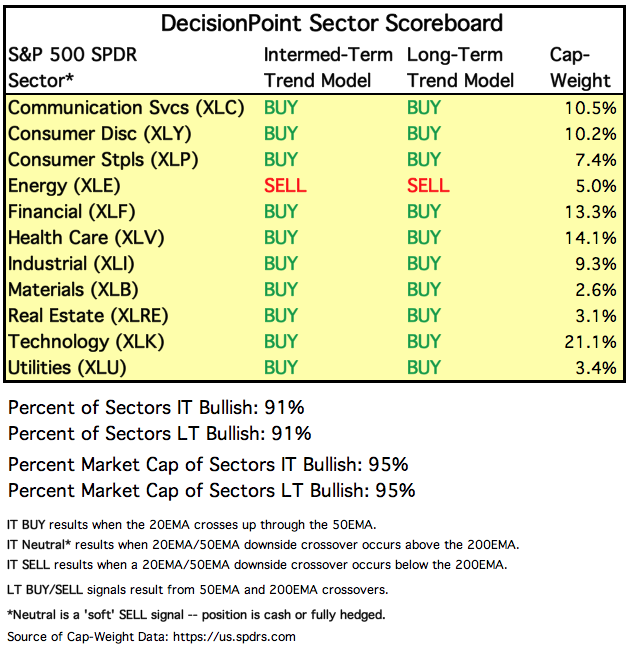
INTEREST RATES
Because interest rates are currently inverted, I will be including a chart so we can watch the situation. In normal circumstances the longer money is borrowed the higher the interest rate that must be paid. When rates are inverted, the reverse is true. It is generally believed that rate inversions result from "a flight to safety." On the chart below, notice that the one-month and three month T-Bills (dotted lines) pay a higher interest rate than the one year through the 10-year T-Bonds. This is a serious problem for the stock market.
EARNINGS 2019 Q1
My quarterly earnings chart is available in a new ChartWatchers article.
STOCKS
IT Trend Model: BUY as of 6/11/2019
LT Trend Model: BUY as of 2/26/2019
SPY Daily Chart: Last Friday I commented on the very high volume for that day, which I said was probably traders getting flat ahead of the weekend. To be more precise, it was probably traders getting flat ahead of this hoiday week. SPY has formed a bearish rising wedge, and the VIX penetrated the upper Bollinger Band, which is short-term bearish. The wedge looks particularly weak because price rose off the bottom of the wedge this week, but it failed to reach the top of the wedge before touching the bottom of the wedge again today.
SPY Weekly Chart: What's not to like? Weekly PMO is positive and rising, and the market is making record highs.
Climactic Market Indicators: Wednesday was an exhaustion climax day, but with very short-term implications.
Short-Term Market Indicators: The STO-B and STO-V are overbought and they have topped. Looking for a short decline next week.
Intermediate-Term Market Indicators: These indicators are not terribly extended, but they are overbought and not likely to exceed their April/May tops.
CONCLUSION: Short-term indicators are overbought, and the rising wedge seems poised to fail, so I'm looking for a short correction next week. Intermediate-term indicators are overbought, and BPIs for broad market indexes are showing a sharp drop in participation compared to the January 2018 top, so we are additionally vulnerable in the intermediate-term. Additionally, the fundamental backdrop is negative with the market overvalued and the inverted yield curve. As I said earlier, if the broad market BPIs break their rising trends from the June low, it would be a very negative sign.
DOLLAR (UUP)
IT Trend Model: NEUTRAL as of 7/5/2019
LT Trend Model: BUY as of 5/25/2018
UUP Daily Chart: The employment report boosted UUP up to the short-term declining tops line. The move was enough to cause the 20EMA to cross up through the 50EMA, thereby generating an IT Trend Model BUY signal. The sideways price movement could generate more whipsaw signals.
UUP Weekly Chart: Price remains just below long-term overhead resistance.
GOLD
IT Trend Model: BUY as of 6/3/2019
LT Trend Model: BUY as of 1/8/2019
GOLD Daily Chart: In spite of a sharp pullback this week gold managed to hold on to the break above long-term resistance, now support.
GOLD Weekly Chart: In this time frame we can see the genesis of the support line. After the vertical ascent from the May price low, a period of consolidation would be in order.
CRUDE OIL (USO)
IT Trend Model: NEUTRAL as of 5/30/2019
LT Trend Model: SELL as of 6/4/2019
USO Daily Chart: Strange looking chart with price bouncing around between the gaps. You'll notice that the island reversal cluster contains a double bottom, and price fulfilled the double bottom projection based upon last week's high.
USO Weekly Chart: The trading range on WTIC is 42 to 76, and I think that 42 is more likely than 76.
BONDS (TLT)
IT Trend Model: BUY as of 12/6/2018
LT Trend Model: BUY as of 1/2/2019
TLT Daily Chart: After making new highs on Wednesday, TLT pulled back sharply on Friday on the strong jobs numbers, and there is now doubt that about a Fed rate cut later this month. The Daily PMO is not encouraging, as it has turned down below the signal line.
TLT Weekly Chart: There was a brief breakout above the line of resistance drawn across the 2016 top, but TLT closed below the line this week. The weekly PMO still looks good.
**Don't miss any of the DecisionPoint commentaries! Go to the "Notify Me" box toward the end of this blog page to be notified as soon as they are published.**
Technical Analysis is a windsock, not a crystal ball.
Happy Charting!
- Carl
NOTE: The signal status reported herein is based upon mechanical trading model signals, specifically, the DecisionPoint Trend Model. They define the implied bias of the price index based upon moving average relationships, but they do not necessarily call for a specific action. They are information flags that should prompt chart review. Further, they do not call for continuous buying or selling during the life of the signal. For example, a BUY signal will probably (but not necessarily) return the best results if action is taken soon after the signal is generated. Additional opportunities for buying may be found as price zigzags higher, but the trader must look for optimum entry points. Conversely, exit points to preserve gains (or minimize losses) may be evident before the model mechanically closes the signal.
Helpful DecisionPoint Links:
DecisionPoint Shared ChartList and DecisionPoint Chart Gallery
Price Momentum Oscillator (PMO)
Swenlin Trading Oscillators (STO-B and STO-V)

